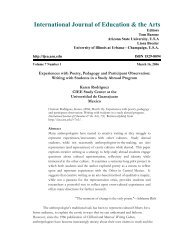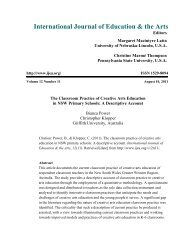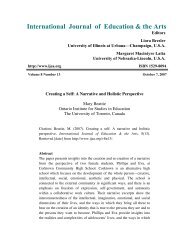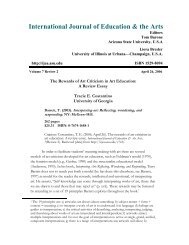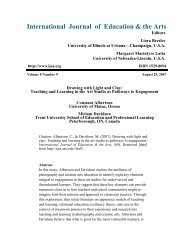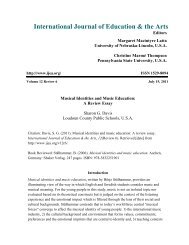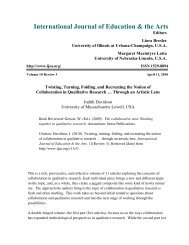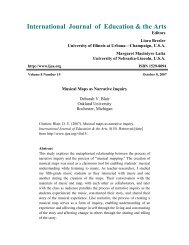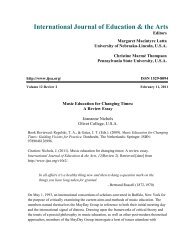On Empathy: The Mirror Neuron System and Art Education
On Empathy: The Mirror Neuron System and Art Education
On Empathy: The Mirror Neuron System and Art Education
You also want an ePaper? Increase the reach of your titles
YUMPU automatically turns print PDFs into web optimized ePapers that Google loves.
IJEA Vol. 10 No. 15 - http://www.ijea.org/v10n15/ 14<br />
struggles, like hers, were caught in the painting.” Moreover, students understood that Karen,<br />
having identified herself with Van Gogh’s story, experienced a modicum of relief because she<br />
felt less alone. As she put it: “I’m not the only one who is crazy.” Like Lipps <strong>and</strong> the acrobat,<br />
Karen had felt herself inside Van Gogh’s own precarious position.<br />
In these preservice classes, it is clear that students understood a resonant harmony, or “felt the<br />
same vibration,” between the presenters <strong>and</strong> their chosen pieces. <strong>The</strong> elegant circuitry of the<br />
mirror neuron system made this resonance possible, creating “magical connections” between<br />
students as they moved from their own body states into those of the presenters <strong>and</strong> through<br />
those body states, into the mind of the presenter, <strong>and</strong> in Karen’s case, into the mind of the<br />
artist. In an application of existential neuroscience, students implicitly understood an<br />
interdependence of self <strong>and</strong> other, self <strong>and</strong> artist that animated their experiences within the<br />
shared space of their caring community. <strong>The</strong> act of presenting themselves <strong>and</strong> their pieces,<br />
which brought students into connection with one another, promoted empathy <strong>and</strong> in their<br />
words, a willingness to offer “some healing,” <strong>and</strong> a “connection with the community.”<br />
Within these connections, art was “brought to life,” animated by more than the motor<br />
simulations its gestural strokes <strong>and</strong> subject matter induced in the students. Through the visual<br />
content, the language used to describe it, <strong>and</strong> participation in dialogue about the piece, there<br />
was an empathic stirring of cells <strong>and</strong> psyche. Literally <strong>and</strong> figuratively, students experienced a<br />
classmate as “the girl in the painting,” or the wind in the chaotic branches scattering the pieces<br />
of Karen’s life. Transposing their stories <strong>and</strong> feelings into objects of art <strong>and</strong> material culture,<br />
they envisioned themselves <strong>and</strong> their classmates, Vischer-like, as “part of the art.” <strong>The</strong>se<br />
intimate experiences went a long way toward restoring “art’s connectedness with the world.”<br />
Laced with emotion <strong>and</strong> fusing lives with resonant objects, students’ stories represented the<br />
“impassioned engagement” of a “connective aesthetics.” This connectedness constituted a<br />
kind of empathic learning that was profoundly meaningful, moving students beyond<br />
intellectual or detached learning to emotional underst<strong>and</strong>ing. Explaining the importance of<br />
such learning, Danesi (1993) points out: “the juxtaposition of artifact with feeling is a<br />
powerful means of making meaning in the world <strong>and</strong> extracting meaning from it” (p. 77). An<br />
art education of empathy promotes such a means.<br />
<strong>Empathy</strong> is required if we are to share so fragile a planet; if we are to underst<strong>and</strong> the gestures<br />
<strong>and</strong> expressions of others, <strong>and</strong> the globally-accessible images <strong>and</strong> icons they produce <strong>and</strong><br />
consume. A connective force, empathy is to be prized by art education, the field poised to<br />
unleash art’s community-building potential <strong>and</strong> to enable young people to grasp the meaning,<br />
the power of connection. An art education of empathy embraces the resonance of mind <strong>and</strong><br />
body, a resonance running deep into the collective soul. This art education builds human<br />
capacities to negotiate the worlds of objects <strong>and</strong> others with care <strong>and</strong> empathic insight.




